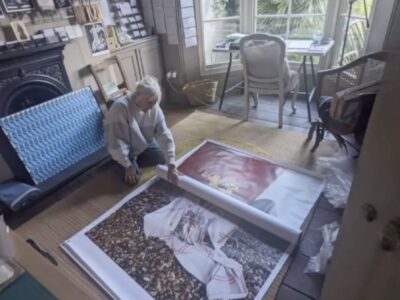Sir Anish Kapoor is one of Britain’s best-known artists.
His work is exhibited in major art institutions across the globe, while large-scale public sculptures such as Cloud Gate (aka The Bean) in Chicago and the Orbit tower next to London’s Olympic stadium have become landmarks and tourist attractions, helping to revive the urban areas in which they were built.
I met with Kapoor in 2012 at his studio, which more accurately is a series of buildings taking up one side of a quiet street in South London and containing offices, different sculpture studios, a fibreglass shop, his concrete studio, and a large white space in which he can think, and place pieces while he considers them, and decides whether they’re ready to show in public.
Kapoor laughs a lot, in a way that is infectious.
He is also generous with his time, showing me round the complex, talking about his routines and creative habits, and patiently explaining works at different stages of completion. There were paintings and sculptures, tiny models of huge works that might never be built, and work in all kinds of different materials from mirrors to concrete, resin to fibreglass, many in his trademark bold, brilliant colours that themselves take years to develop and perfect.
“I feel I’m only a young artist, I’ve hardly started!” he told me, though he was born in 1954. “There’s so much to do! We live at a time when there’s just the most incredible possibility.”
He talked with excitement about new questions being considered in psychology and philosophy, or advances in our understanding of physics and biology — and how all of this informs his own work.
You’re working on so many different projects here!
I’m forever looking for different ways of doing things. And I get there slowly, very slowly! One of the things one has to do — or one can afford to do — as an artist is to take risks, go to places which are completely new or experimental. Or unknown, or rubbish, or however it turns out.
One has to continually open that space and say, ‘Look, I don’t know what it means, I don’t know where it goes, I don’t know what it’s about. But I’m going to do it anyway.’
Also, I’d get bored. Can you imagine, making the same thing all the time? It’s just boring! I don’t want to do it!
How do you keep quality control?
I try to not let anything out of the studio for at least 3–6 months, till I’ve had time to sit with it, watch it, be with it.
How many of them end up on the reject pile?
I don’t believe in rejects!
The learning pile?
(laughs) Sometimes a work just needs time. You need to understand it. Maybe I need to do more, maybe I need to go further. It’s easy to say, “Oh yes that’s a good one, that’s not a good one.” But that’s not really the process.
Each object, each thing is a problem, a proposition. And the question is, how do you take that proposition further, how do you conclude its story?
So is there a warehouse full of the interim pieces?
There is, not far from here. I’m reluctant to throw things away, because I just have the sense that at some point, I’ll come back to them.
There is a fantasy that the great artist makes no mistakes — just does the piece. Everything is all done, it’s all there, it’s all resolved. And I don’t believe it! I don’t think that’s how it works.
There’s always this sort of generative process, that is somewhat resolved, half-resolved, working towards. And some of that work is shown in public and some of it is not. It depends.
I love the idea of this warehouse of your thought processes…
Haha! I think of it with horror! But I do go back to it. Because inevitably you think you’re doing something new, and you’re not. You’re back at the same old questions.
So I go there occasionally, look at it. And we’re always adding to it. Things are always being moved down there, and back from there. So there’s a lot of, ‘Oh that’s more interesting than it was at the time, let’s bring it back!’ And then try and get it into the world, see if it can be resolved.
Some of it must be to do with what’s technically possible, at the time. You couldn’t have done Cloud Gate ten years before.
Even when we did make it, it was pretty difficult! I had the idea, but then I had to find someone who could take it on.
Everyone I approached was just horrified, because they knew that what I was after was something close to perfection.
And then I found Ethan Silva, this fellow in California, a very kind of can-do guy who had never made it anything like it before. He’d only made boats. But I felt that he had the right character, the right circumstances in terms of his workshop and his facilities.
So we talked about how to do it, and then we approached Boeing, and bought two three-dimensional milling machines. They make metal very, very flat. But they don’t do curves. So we had to modify these machines to do curves. Then, once we’d figured that out, the process became clearer.
The whole thing should have taken two years to build, it took us seven or eight. But we did it, eventually. It was a nightmare for everybody concerned. But we did it!
How does your daily meditation practice inform your work?
I’ve been doing it for many, many years, and I do find it very important. It’s as if one is simply sitting with oneself, and all there is, in the end, is the breathing. And the voices that won’t go away, for ever and ever!
With two children, how do you find time to meditate every day?
My children are grown up now. They do their own thing. But really, you just have to get up earlier!
What’s your work routine?
I travel a lot for work. But when I’m in London, I like to spend 40 minutes to an hour sitting in meditation first thing. Then I try to be at the studio by 9am at the latest, and work through to 6pm.
Just the steady thing, the sameness of it all, is important. I used to work at the weekends, but I think it’s really important to have a lot of time away. I take a lot of holidays, when I do nothing. But I can’t do that for too long. Two or three days and I’m bored to death!
Can you imagine a time when you’ll stop?
Stop making work? No! I’d just vegetate and get old. I’m too restless. And also, it’s such fun. It’s how I remain intellectually and spiritually alive.
Do you enjoy the business side of the art world?
To be successful as an artist, you’ve got to have talent, you’ve got to be able to understand what it means. But you’ve also got to be reasonably good at business. I take all of that as part of the deal. If I didn’t sell work, I wouldn’t be able to make work.
Good art has always been near money. Titian, for example, was a hugely wealthy man. Not only did he make money from his work, but he also was a trader in wood in Venice.
I don’t think there’s any embarrassment about that. I’m not embarrassed. Yes, I make a lot of money. It doesn’t bother me. Why should it? I’m so fortunate to be able to do what I do, do it all day every day, make a really good living from it.
Now that so many people want you to do exhibitions, talks, interviews, is there still time to think and work?
I’m a difficult bugger, I’m afraid. I say no all the time. The amount of times I contemplated saying no to this interview, I can’t tell you! (laughs)
But I have to. I don’t mean to be arrogant, but I have to protect that space. There are some things worth doing, and other things that may be perfectly worthy and very good — but they don’t take my conversation any further.
I interviewed Anish Kapoor for the Telegraph magazine. You can read the original feature here.






Great work…